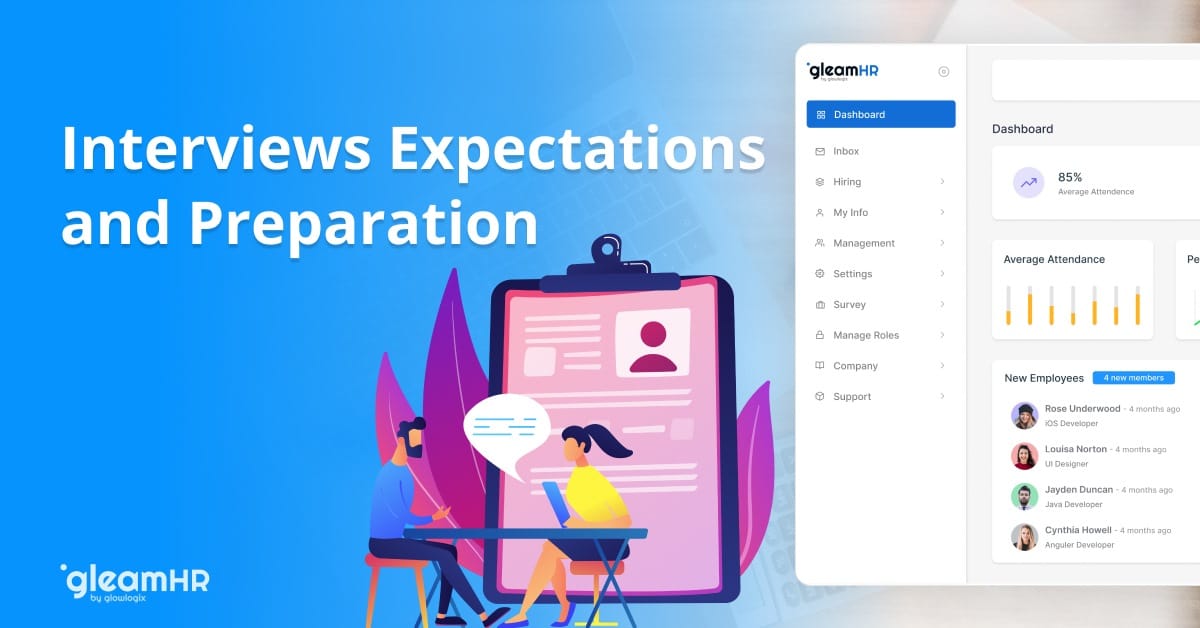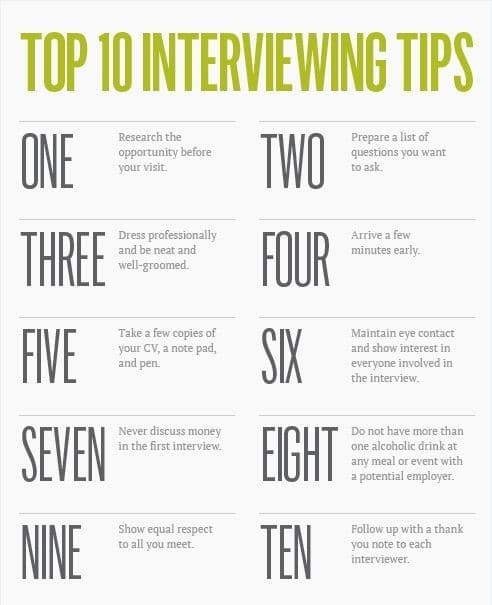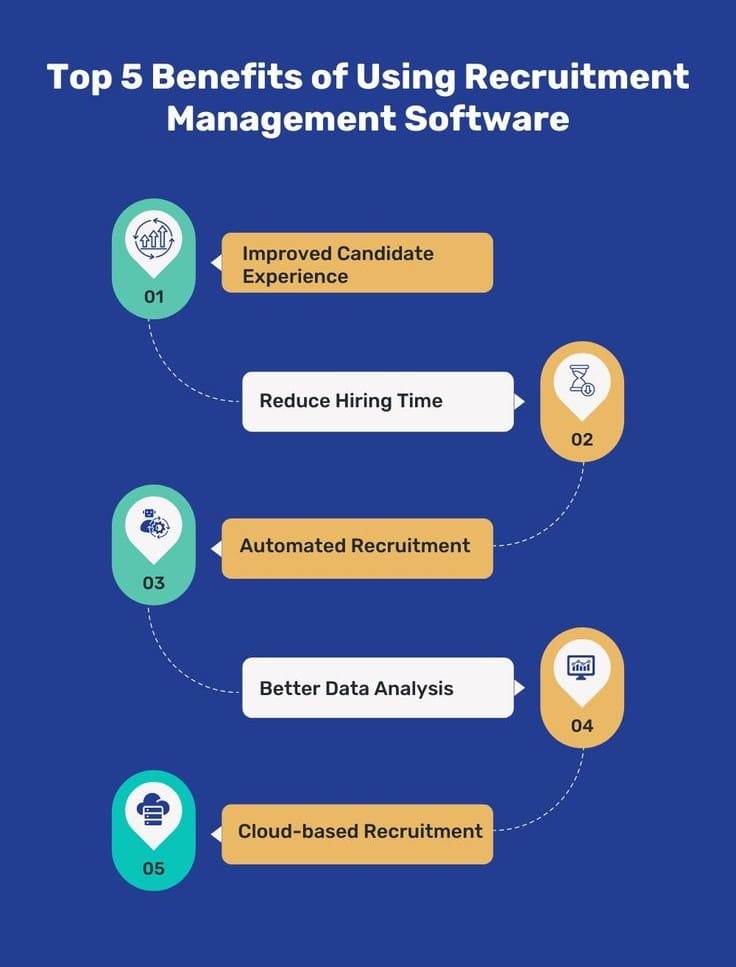In the dynamic world of human resources, the process of hiring new employees has evolved significantly over the years. Today, modern businesses rely on a structured and efficient recruitment and selection process to find the best candidates for their teams. One crucial component of this process is the interview stage. In this blog post by GleamHR, we will dive into the interview process, discuss what you can expect, and provide valuable insights on how to prepare effectively. We will also explore the role of recruitment automation software, the significance of new hire onboarding, and the best ways to recruit employees.
Understanding the Hiring Process
Before we delve into the interview process, it’s essential to have a broad understanding of the entire hiring process. This process typically consists of several stages, with the interview being just one of them. Let’s briefly outline the seven steps in the recruitment process:
Identify the Need:
The process begins with identifying the need for a new employee. This could be due to business growth, employee turnover, or a specific project requirement.
Job Posting:
Once the need is identified, a job posting is created and published on various platforms, including the company’s website for hiring employees, job boards, and social media.
Resume Screening:
HR professionals or automated systems review resumes and applications to shortlist candidates who meet the basic qualifications.
Initial Screening:
This stage involves an initial round of screening, which may include a phone interview or an online assessment to assess candidates’ suitability further.
Interview Process:
The interview process is where candidates are evaluated more comprehensively. This is the stage we’ll focus on in detail in this blog.
Reference Checks:
After interviews, reference checks are conducted to validate candidates’ qualifications and work history.
Offer and Onboarding:
Finally, the selected candidate receives a job offer, and the onboarding process begins, ensuring a smooth transition into the organization.
The Interview Process: What to Expect
The interview process is often the most critical step in selecting the right candidate for a job. Here’s what you can expect during this stage:
Preparation:
As a candidate, you should be well-prepared for the interview. This includes researching the company, understanding the job description, and practising common interview questions.
Types of Interviews:
Interviews can take various forms, such as one-on-one interviews, panel interviews, behavioral interviews, and technical interviews. The format depends on the company’s hiring process and the specific role.
Assessment Methods:
Companies may use different assessment methods, including skills tests, personality assessments, and situational judgment tests, to evaluate candidates thoroughly.
Behavioral Questions:
Expect questions about your past experiences and how you handled specific situations. Use the STAR method (Situation, Task, Action, Result) to structure your responses.
Technical Questions:
For technical roles, be prepared for questions that assess your expertise in the relevant field.
Cultural Fit:
Employers often evaluate candidates for cultural fit, assessing whether you align with the company’s values and work culture.
Questions for the Interviewer:
At the end of the interview, you’ll likely have the opportunity to ask questions. Prepare thoughtful inquiries to demonstrate your interest in the role and the company.
Follow-up:
After the interview, it’s a good practice to send a thank-you email expressing your gratitude for the opportunity and reiterating your interest in the position.
How to Prepare for the Interview Process
Effective preparation is key to performing well in interviews. Here are some tips to help you get ready:
Research the Company:
Understand the company’s mission, values, products or services, recent news, and any notable achievements. This knowledge will enable you to tailor your responses to align with the company’s culture and goals.
Study the Job Description:
Analyze the job description thoroughly, identifying the key responsibilities and qualifications required. Be ready to demonstrate how your skills and experiences align with the role.
Practice Interview Questions:
Practice answering common interview questions, especially behavioural questions. Use the STAR method to structure your responses and provide concrete examples of your skills and achievements.
Mock Interviews:
Conduct mock interviews with a friend or mentor to simulate the interview experience. This will help you gain confidence and receive valuable feedback.
Prepare Questions:
Develop a list of thoughtful questions to ask the interviewer. This shows your interest in the role and company and can help you assess if the organization is the right fit for you.
Dress Professionally:
Choose appropriate attire based on the company culture and industry standards. When in doubt, it’s better to be slightly overdressed than underdressed.
Organize Your Materials:
Bring multiple copies of your resume, a notepad, and a pen to the interview. Having these materials on hand can be helpful during the conversation.
The Role of Recruitment Automation Software
Recruitment automation software has become a game-changer in streamlining the hiring process. These sophisticated tools leverage technology to automate various aspects of recruitment, making it more efficient and effective. Here’s how recruitment automation software by GleamHR can benefit both employers and candidates:
Faster Screening:
Automation software can quickly sift through a large number of applications, identifying the most qualified candidates based on predefined criteria.
Improved Communication:
Automated systems can send notifications and updates to candidates throughout the recruitment process, keeping them informed and engaged.
Data Analytics:
These tools collect and analyze data, providing valuable insights into recruitment trends and candidate performance.
Enhanced Candidate Experience:
Candidates appreciate a smooth and efficient application process, and automation software can provide just that.
Reduced Bias:
Automation can help reduce unconscious bias in the screening process by focusing on qualifications rather than subjective factors.
As a candidate, it’s essential to be aware of the role of automation in the hiring process. Tailor your application materials to ensure they are compatible with automated screening systems. Keywords from the job description and a well-structured resume can improve your chances of passing through the initial screening stages.
The Significance of New Hire Onboarding
The hiring process doesn’t end with the offer acceptance; it extends to the crucial phase of new hire onboarding. This step is essential for integrating new employees into the organization smoothly. Here are some key aspects of onboarding:
Orientation:
New hires typically undergo an orientation program to familiarize themselves with company policies, procedures, and the workplace environment.
Training and Development:
Companies often provide training and development opportunities to help new employees acquire the skills they need to excel in their roles.
Mentoring:
Some organizations assign mentors or buddies to new employees to provide guidance and support during the initial stages of employment.
Integration:
Onboarding helps new hires integrate into the company culture, fostering a sense of belonging and alignment with the organization’s values.
Feedback and Evaluation:
Regular feedback and evaluation sessions during the onboarding process help new employees understand their strengths and areas for improvement.
A successful onboarding process not only benefits the new hire but also the company by ensuring that employees quickly become productive and engaged members of the team.
The Best Ways to Recruit Employees
Recruiting the right employees is a critical task for any organization. Here are some best practices to consider when recruiting candidates:
Employer Branding:
Build a strong employer brand by showcasing your company’s culture, values, and benefits. A positive employer brand can attract top talent.
Utilize Multiple Channels:
Don’t rely on a single platform for hiring. Use a combination of job boards, social media, and employee referrals to cast a wide net.
Employee Referral Programs:
Encourage your current employees to refer candidates from their professional networks. Employee referrals often yield high-quality candidates.
Leverage Networking:
Attend industry events, conferences, and networking events to connect with potential candidates.
Offer Competitive Compensation:
Ensure that your compensation packages are competitive within your industry and region to attract top talent.
Continuous Improvement:
Regularly review and refine your recruitment process based on feedback and performance metrics.
Conclusion:
In conclusion, the interview process is a crucial step in the overall hiring process. To succeed in interviews, candidates must prepare thoroughly, showcase their qualifications, and align themselves with the company’s values. Recruitment automation software by GleamHR plays a significant role in making the process more efficient, and new hire onboarding ensures a smooth transition into the organization. By following best recruitment practices, both employers and candidates can make the most of the hiring process, leading to successful and satisfying job placements.
FAQs:
What are the 5 stages of the interview process?
The interview process is typically broken down into 5 stages:
- Introductions.
- Small Talk.
- Information Gathering.
- Question/Answer.
- Wrapping Up.
What is the interview process?
The interview process is a multi-stage procedure for selecting new employees. These stages typically involve job interviews, which can take various formats, including one-on-one sessions, group interviews, or panel discussions. Interviews may be conducted in person, over the phone, through email, or using video conferencing tools.
3 Steps to Improve Your Interview Process:
- Positive Impressions: Recruiters must present the company well, understand the job, and reflect the company culture during phone screens to create a favourable impression on candidates.
- Efficient Tools: Employ technology for consistency, insights on candidates, and scalability. Structured interviews and tools like BrightHire ensure fairness and streamline hiring.
- Team Collaboration: Make interviews a team effort by planning personnel, stages, and questions to prevent redundancy and maintain transparency.




